OEFPBondType
This namespace contains bond typing options that can be used when generating Circular, Path of Tree fingerprints. Bond type options control how the bonds of the enumerated circular, path or tree fragments are encoded during the fingerprint generation.
The OEFPBondType namespace contains the following constants:
Constant name |
Combination of |
|---|---|
Note
The images in this sections visualize the effect of the various bond typing options.
See also
Visualizing Molecule Similarity section
See also
OEFPAtomTypenamespaceOEMakeCircularFPfunctionOEMakePathFPfunctionOEMakeTreeFPfunctionAtom and Bond Typing section
BondOrder
This flag indicates that bond order information is encoded into
the generated fingerprint, i.e., if two fragments (either
circular, path or tree) are composed of bonds with different bond
orders (the value returned by the GetOrder
method) then the two fragments will be mapped to different bits
of the fingerprint.
Table: Example of using the BondOrder option
demonstrates the effect of using the OEFPBondType_BondOrder flag.
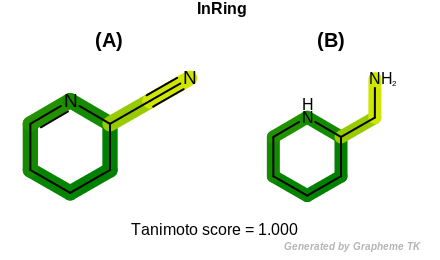
|

|
Chiral
This flag indicates that chiral and non-chiral bonds (the value
returned by the OEBondBase.IsChiral method) are
distinguished during the circular, path, the tree fingerprint
generation.
Table: Example of using the Chiral option
demonstrates the effect of using the OEFPBondType_Chiral flag.
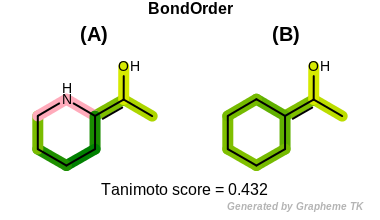
|

|
Note
Cis and trans chiral bonds can not be distinguished when the
OEFPBondType_Chiral flag is set.
Fingerprints generated for molecules C\C=C/C and C/C=C/C
will always be identical.
(See example in Figure: Example of molecule similarity of stereoisomers).

Example of molecule similarity of cis-trans stereoisomers
InRing
This flag indicates that bond topology information is encoded into
the generated fingerprint, i.e., if two fragments (either
circular, path or tree) are composed of bonds with different bond
topology (the value returned by the
OEBondBase.IsInRing method) then the two
fragments will be mapped to different bits of the fingerprint.
Table: Example of using the InRing option
demonstrates the effect of using the OEFPBondType_InRing flag.
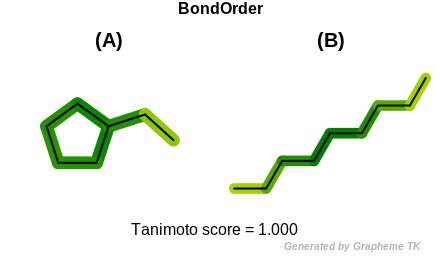
|
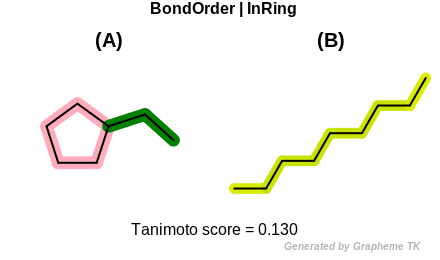
|
DefaultBond
Same as OEFPBondType_DefaultPathBond constant.
DefaultCircularBond
Same as the OEFPBondType_BondOrder constant.
See example in Figure: Circular fingerprint similarity with default circular atom and bond typing.
This constant is used as bond typing parameter when a default
Circular fingerprint is
generated by the following functions:
OEMakeFP(OEFingerPrint &, const OEMolBase &,OEFPType_Circular)
See also
OEFPAtomType_DefaultCircularAtomconstant
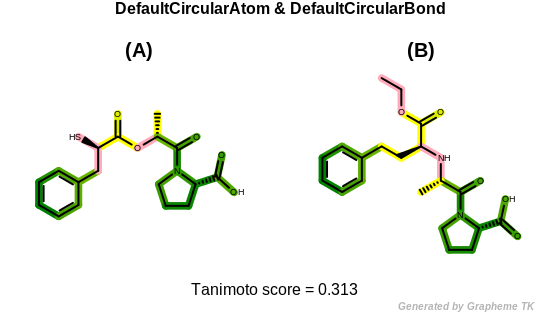
DefaultCircularVSBond
The default bond typing for the circular fingerprint that is designed for virtual
screening. Currently it’s the same as OEFPBondType_DefaultCircularBond.
DefaultPathBond
The bitwise OR’d value of the following bond typing options:
See example in Figure: Path fingerprint similarity with default path atom and bond typing.
This constant is used as bond typing parameter when a default
Path fingerprint is
generated by the following functions:
OEMakeFP(OEFingerPrint &, const OEMolBase &,OEFPType_Path)
See also
OEFPAtomType_DefaultPathAtomconstant
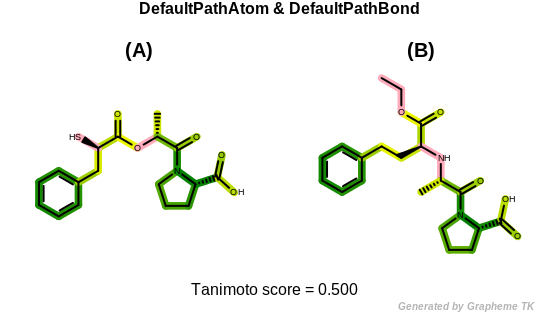
Path fingerprint similarity with default tree atom and bond typing
DefaultPathVSBond
The default bond typing for the tree fingerprint that is designed for virtual
screening. Currently it’s the same as OEFPBondType_DefaultPathBond.
DefaultTreeBond
Same as the OEFPBondType_BondOrder constant.
See example in Figure: Tree fingerprint similarity with default tree atom and bond typing.
This constant is used as bond typing parameter when a default
Tree fingerprint is
generated by the following functions:
OEMakeFP(OEFingerPrint &, const OEMolBase &,OEFPType_Tree)
See also
OEFPAtomType_DefaultTreeAtomconstant
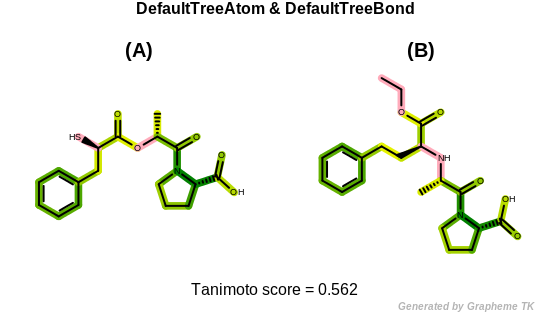
Tree fingerprint similarity with default tree atom and bond typing
DefaultTreeVSBond
The default bond typing for the tree fingerprint that is designed for virtual
screening. Currently it’s the same as OEFPBondType_DefaultTreeBond.
None
No bond properties are encoded when generating a fingerprint.